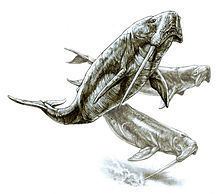Phylum Chordata Order Even-toed ungulate | Rank Genus | |
 | ||
Family †OdobenocetopsidaeMuizon 1993 Similar Metriorhynchus, Trinacromerum, Cetotherium, Basilosaurus, Leptocleidus | ||
Odobenocetops (/ˌoʊdəbiːˈnɒsᵻtɒps/) was a small toothed whale known from Peru and Chile, they are restricted to Neogene (mostly Miocene), they were believed to be somewhat extinct at the Pliocene. It had two tusks, and, in some fossils, one tusk was longer than the other.
Contents

Jurassic park builder dna aquatic odobenocetops
Phylogeny
Odobenocetops can be identified as a cetacean based on several features unique to this order:
- The presence of large air sinuses in the auditory region connected to large pterygoid sinuses.
- The large supraorbital process of the frontal bone overhanging the orbital region.
- Narial fossae opening dorsally (thought not at the apex of the skull like in other cetaceans.)
- The absence of a true cribriform plate (a bony blade separating the nares). In Odobenocetops, a group of foramina in this plate allows the passage of olfactory nerves connected to the small olfactory lobes in the brain. In other cetaceans, the olfactory nerves are similarly present but strongly reduced.
- The elbow joint is immobile, as shown by a single partial forelimb.
Murakami et al. 2014 placed Odobenocetopssidae in a large clade together with Phocoenidae (porpoises), Monodontidae (narwhal and beluga), and Albireonidae (extinct porpoise-like). This clade originated in the Pacific Ocean in the Langhian (15-13 ma) and diversified from there during the Serravallian and Tortonian (13-7 ma). According to the morphological analysis of Murakami et al., Odobenocetops belongs to the middle Pliocene.
Etymology
The generic name Odobenocetops comes from Greek odon, "tooth", and baino, "walk" and Latin cetus, "whale", and ops, "like", meaning "cetacean that seems to walk on its teeth" but is also referring to the similarity to the walrus (Odobenus).
Description
Odobenocetops was an early member of the dolphin superfamily, more closely related to narwhals than dolphins, with tusks projecting towards the rear of its body. It measured about 2.1 m (6.9 ft) long and weighted between 150 and 650 kg. Its neck articulations show that it was very flexible, being able to turn its head over 90 degrees. This, coupled with its broad snout, similar to that of a walrus, suggests that it was a bottom feeder, searching for mollusks and sucking them out of their shells with a powerful tongue.
The rostrum of Odobenocetops is short and rounded, in contrast to the elongated rostra found in other cetaceans. The bony nares are located near the tip of the skull, in contrast to the blowholes of whales and dolphins located on the top of the skull. The palate is arched and toothless like in walruses. The eye-sockets are oriented upwards and sideways, and not laterally like in other dolphins. In other odontocetes, parts of the frontal and maxillae cover the temporal fossae. In Odobenocetops, these bones are reduced and narrowed so that the temporal fossae is open dorsally. The periotic and tympanic bones are similar to those in other dolphins. No mandible has been recovered and only few postcranial elements. The body length has been estimated to 3–4 metres (9.8–13.1 ft).
The holotype of the younger species O. leptodon was found with both tusks in situ, the right one 1.35 metres (4 ft 5 in) long, the erupted portion 1.07 metres (3 ft 6 in), the left tusk was only 25 centimetres (9.8 in) but a wear facet indicates that it was erupted. The skull of O. leptodon differs from that of O. peruvianus in the absence of a premaxillary foramina and the presence of a dorsal fossa (shallow depression) on the premaxilla. This fossa suggests the presence of a melon in O. leptodon, an organ either absent or strongly reduced in O. peruvianus. On the other hand, the orbit in O. leptodon has an anterior edge that is only slightly concave, whereas it is deeply notched in O. peruvianus which suggests that O. peruvianus used binocular vision.
Analyses of neck bones of both species suggest that Odobenocetops swam with its head bent ventrally, which would have brought the long right tusk in males in parallel to the body and allowed O. leptodon good use of its binocular vision.
Tusks
Perhaps the most striking discovery was that of a male O. leptodon skull with a tusk significantly longer than the other. On the right side of the body, the tusk was often 1.2 m (3.9 ft) long, but on the left it could only grow up to 25 centimetres (9.8 in) long. Being the only male O. leptodon skull known, it is not safe to say it was present in all male individuals of the species. Being too brittle, the tusk was probably held parallel to the body. It might have been used to search out food, or as a sensory organ like narwhal tusks. Even though they are closely related to these primitive whales, the tusks were gained by convergent evolution. Tim Haines thought that the tusks could be used during the mating season in jousts over females.
The abstract of Muizon 1993 helps to explain why this is so:
The occurrence of tusks in Odobenocetops is a convergence with narwhals. However, in narwhals the male tusk is implanted in the left maxilla, whereas in Odobenocetops it is implanted in the right premaxilla. The tusks in these two genera are therefore not homologous.
